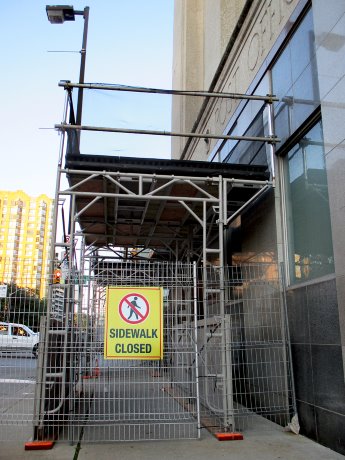WINDSOR, ONT. — Windsor’s main federal government building is increasingly falling into disrepair, posing a threat to pedestrians and motorists below.
The Paul Martin Building, named for the famous senator from Windsor and father of former Prime Minister Paul Martin Jr., is a six–storey block-long edifice on Windsor Ont.’s main downtown artery, built in the 1930s, and housing several hundred Canada Revenue Agency workers and a smattering of other federal employees.
So dangerous has the building become that monthly building inspection reports have indicated a 90 to 100 per cent likelihood of a piece of the facade, weighing as much as five kilograms, could break loose and fall to the ground.
The reports by Kitchener-based Read Jones Christoffersen, hired by Ottawa to keep regular tabs on the building, also found the chance of rock falling on a pedestrian at three out of five on a risk exposure scale, despite the fact there is scaffolding below.
The engineering firm was blunt in its assessment in reports obtained by The Windsor Star under Access to Information legislation. "The stone facade is in poor condition and should be rehabilitated immediately," it said.
Read Jones Christoffersen described "lack of an aggressive maintenance schedule" and "improper" materials used in previous repairs that were responsible for the building’s deteriorating condition.
As of this past March the firm documented 310 pieces of broken stone, 342 instances of failed caulking, 22 cracked headers, 1,080 instances of failed mortar, 167 instances of cracked stone, and 545 of 3,170 stones in the cladding having "irreversible damage."
The reports indicate the government was concerned with deterioration as far back as 1999, triggering annual building inspections, which then became monthly in August 2011.
And this summer Ottawa upgraded the scaffolding’s "overhead protection," Public Works and Government Services Canada’s (PWGSC) spokeswoman Annie Joannette said.
As well, pedestrians can no longer walk under the scaffolding but have to cross the street, though there is still city sidewalk around it which people still use.
Meanwhile the building’s longtime main entrance on Ouellette Avenue has also been closed.
In March, 545 of the 3,170 stones of the building’s cladding, or 17 per cent, had "experienced irreversible damage," reported Read Jones Christoffersen, which declined a request for comment from Daily Commercial News. That’s a 10 per cent increase from 498 stones identified in April 2013.
"It appears that the deterioration is accelerating, which will most likely lead to more frequent and more severe stone failures, with an increasing risk of one or more larger pieces of stone falling from the building down to street level," said the engineers.
The inspections also found there could be hidden damage from oxide jacking behind the cladding. That’s where rusting of steel supports seeps through cracks and puts pressure on the stone facade.
But Joannette said the building remains safe.
"Since 2006, PWGSC has invested $6.2 million to maintain the asset and has an annual maintenance schedule for the building in accordance with industry best practices," she told DCN.
"As part of our due diligence, PWGSC uses the monthly, third-party inspection reports to identify any work requiring immediate attention, and has taken action to address immediate repair needs."
Norm Becker, a longtime Windsor engineer in private practice that specializes in rehabilitating historic buildings and teaches at the University of Windsor, called the lack of maintenance of the limestone clad building "appalling."
Becker said he was surprised $6.2 million has been spent on repairs.
"That’s certainly not consistent with what I’ve reviewed of the reports," he said. "It’s certainly not evident from the exterior. While they may have done interior work, it’s certainly not the kind that has improved the stability of the stone veneer."
Becker said even upgraded scaffolding can’t be trusted to prevent all potential injuries from falling material.
"There are projecting window ledges and other ledges," he said. "So if a piece falls off the upper part of the building and kicks off of one of these ledges, it’s going horizontally and could go past the scaffolding."
PWGSC’s Joannette says it would cost $19.6 million to fully repair the building, which federal officials have said is not good use of tax dollars.
PWGSC is moving towards putting the building on the market although there are fears in the community the building won’t find a buyer and will be demolished.
It issued a draft Request for Information on June 4, for the "long-term accommodation requirements of our client, the Canada Revenue Agency," as well as for "the future use or disposal" of the Paul Martin Building.











Recent Comments
comments for this post are closed